The Three Caballeros
6.6 /10 1 Votes
Duration Country United States | 6.6/10 IMDb Genre Animation, Family, Fantasy | |||||||||||||||||||||||||||||||||
 | ||||||||||||||||||||||||||||||||||
Language EnglishSpanishPortuguese Director Norman Ferguson (supervising director), Clyde Geronimi, Jack Kinney, Bill Roberts, Harold Young (sequence directors) Directors Norm Ferguson, Harold Young Songs Obertura—Los Tres Caballeros Cast (The Brazilian Girl (as Aurora Miranda of Brazil)), (Mexico Girl (as Carmen Molina of Mexico)), Dora Luz (Mexico Girl (as Dora Luz of Mexico)), (Narrator for 'The Cold-Blooded Penguin' / Professor Holloway), (Donald Duck (voice)), Joaquin Garay (Panchito (voice))Similar movies Walt Disney Animated Classics movies Tagline A CARTOON FIESTA of FUN and FANTASY! | ||||||||||||||||||||||||||||||||||
Los tres caballeros os tres caballeros the three caballeros spa port eng
The Three Caballeros is a 1944 American live-action animated musical package film produced by Walt Disney and released by RKO Radio Pictures. The film premiered in Mexico City on December 21, 1944. It was released in the United States on February 3, 1945 and in the UK that March. The seventh Disney animated feature film, the film plots an adventure through parts of Latin America, combining live-action and animation. This is the second of the six package films released by Walt Disney Productions in the 1940s, following Saludos Amigos (1942).
Contents
- Los tres caballeros os tres caballeros the three caballeros spa port eng
- Three amigos song the three caballeros 1944
- Plot
- The Cold Blooded Penguin
- The Flying Gauchito
- Baa
- Las Posadas
- Mexico Ptzcuaro Veracruz and Acapulco
- You Belong to My Heart
- Donalds Surreal Reverie
- Influence
- Cast and characters
- Soundtrack
- Nominations
- Television
- Theatrical re releases
- Home video
- Critical reception
- Other media
- References

The film is plotted as a series of self-contained segments, strung together by the device of Donald Duck opening birthday gifts from his Latin American friends. Several Latin American stars of the period appear, including singers Aurora Miranda (sister of Carmen Miranda) and Dora Luz, as well as singer and dancer Carmen Molina.
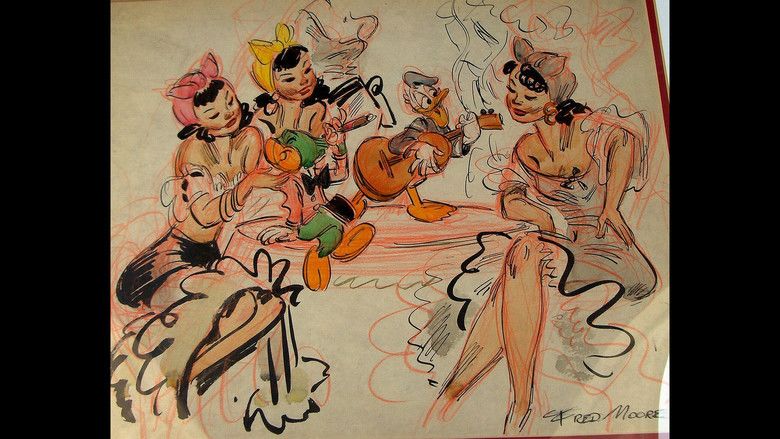
The film was produced as part of the studio's good will message for South America. The film stars Donald Duck, who in the course of the film is joined by old friend José Carioca, the cigar-smoking parrot from Saludos Amigos, who represents Brazil, and later becomes friends with a pistol-packing rooster named Panchito Pistoles, who represents Mexico.
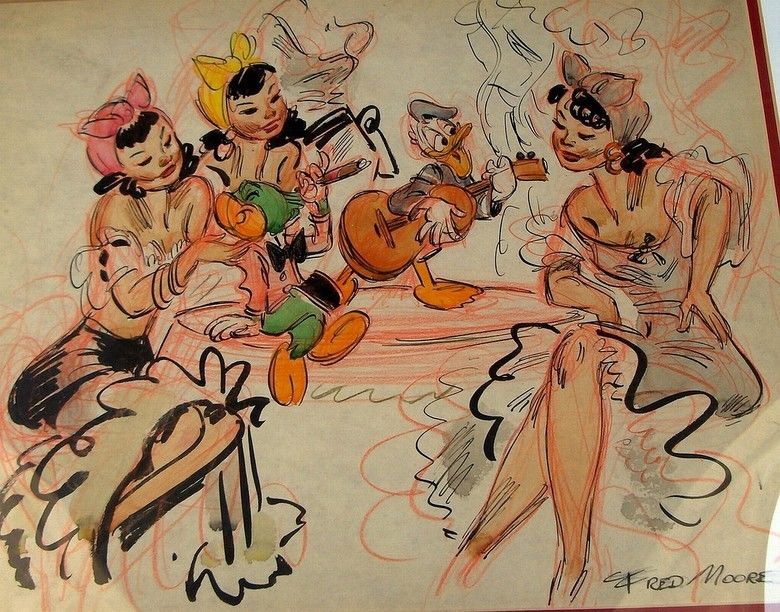
Three amigos song the three caballeros 1944
Plot
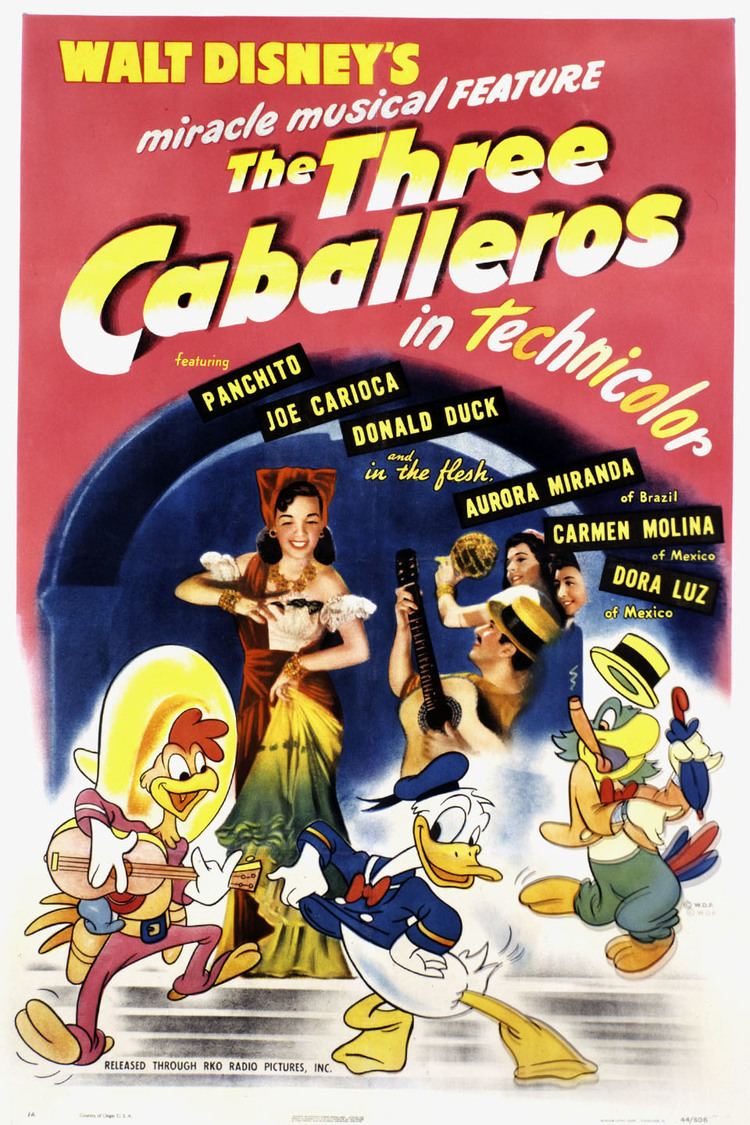
The film consists of seven segments, each connected by a common theme. In the film, it is Donald Duck's birthday (namely Friday the 13th), and he receives three presents from friends in Latin America. The first present is a film projector, which shows him a documentary about birds. During the documentary, he learns about the Aracuan Bird, who received his name because of his eccentric song. The Aracuan also makes several appearances throughout the film.

The next present is a book given to Donald by José. This book tells of Bahia (spelled "Baía" in the film), which is one of Brazil's 26 states. José shrinks them both down so that they can enter the book. Donald and José meet up with several of the locals, who dance a lively samba, and Donald ends up pining for one girl, but fails. After the journey, Donald and José leave the book.

Upon returning, Donald realizes that he is too small to open his third present. José shows Donald how to use "black magic" to return himself to the proper size. After opening the present, he meets Panchito, a native of Mexico. The trio take the name "The Three Caballeros" and have a short celebration. Panchito then presents Donald's next present, a piñata. Panchito tells Donald of the tradition behind the piñata. José and Panchito then blindfold Donald, and have him attempt to break open the piñata, which eventually reveals many surprises. Donald ends the celebration by being fired away by firecrackers in the shape of a ferocious toy bull (with which the firecrackers are lit by José with his cigar).
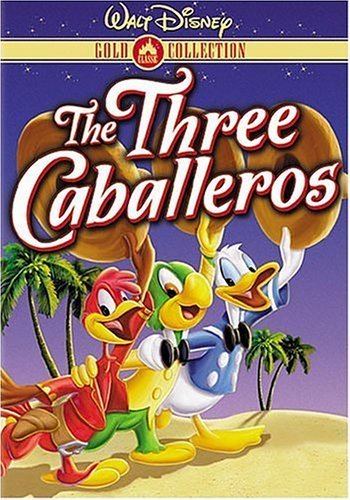
Throughout the film, the Aracuan Bird appears at random moments. He usually taunts everyone with his madcap antics, sometimes stealing José's cigar and trying to make José jealous. His most famous gag is when he re-routes a train that Donald and José are riding on by drawing new tracks, causing the train to disassemble. He returns three or four years later in Melody Time (1948).
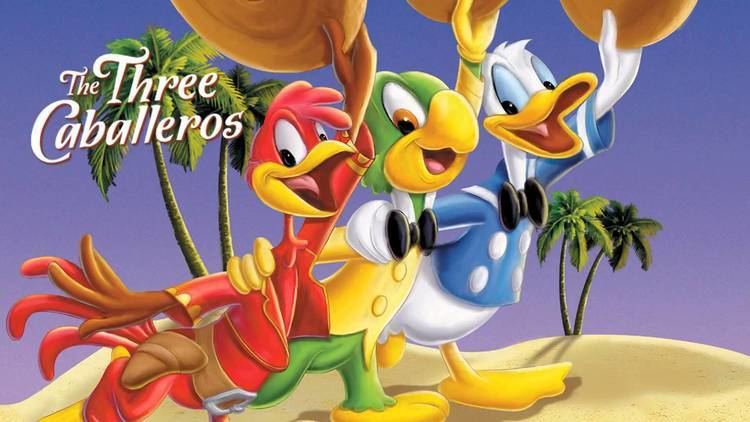
The film consists of seven segments:
The Cold-Blooded Penguin
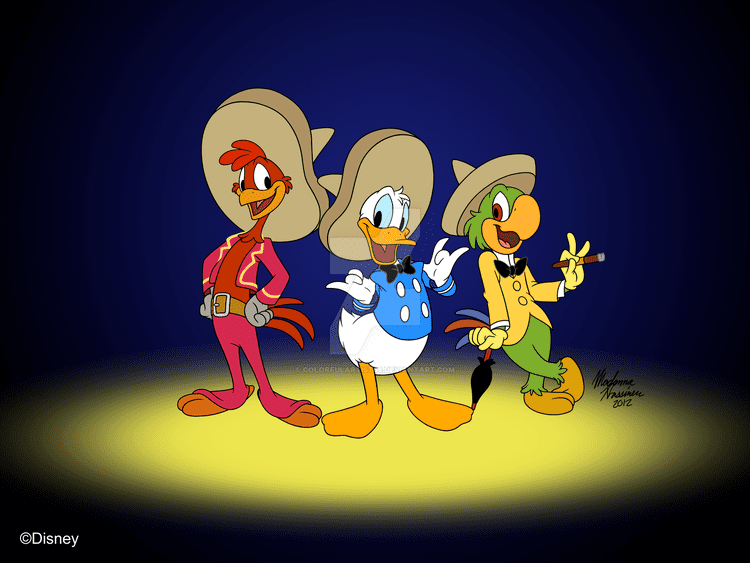
This segment is narrated by Sterling Holloway, reproducing images of the penguins of Punta Tombo in Argentina along the coast of Patagonia. In the segment, a penguin named Pablo is so fed up with the freezing conditions of the South Pole that he decides to leave his home for warmer climates landing on the Galápagos Islands.
The Flying Gauchito
This segment involves the adventures of a little boy from Uruguay in the English version (with adult narration provided by Frank Graham), and from Argentina in the Spanish version, and his winged donkey, who goes by the name of Burrito (which is Spanish for "little donkey").
Baía
This segment involves a pop-up book trip through the Brazilian state of Bahía, as Donald and José meet up with some of the locals who dance a samba and Donald pining for one of the women, portrayed by singer Aurora Miranda.
Las Posadas
This is the story of a group of Mexican children who celebrated Christmas by re-enacting the journey of Mary, the mother of Jesus and Saint Joseph searching for room at the inn. "Posada" meant "inn", or "shelter", and their parents told them "no posada" at each house until they came to one where they were offered shelter in a stable. This leads to festivities including the breaking of the piñata, which in turn leads to Donald Duck trying to break his own piñata as well.
Mexico: Pátzcuaro, Veracruz and Acapulco
Panchito gives Donald and José a tour of Mexico on a flying sarape, or magic carpet. Several Mexican dances and songs are learned here. A key point to what happens later is that Donald is pining for some more ladies again, tries to hound down every single one he sees, and gain return affections, but once more he fails every time and ends up kissing José while blindfolded.
You Belong to My Heart
The skies of Mexico City result in Donald falling in love with singer Dora Luz. The lyrics in the song itself play parts in the scenarios as to what is happening as well.
Donald's Surreal Reverie
Several imagined kisses lead to Donald going into the "Love is a drug" scene. Donald constantly envisions sugar rush colors, flowers, and Panchito and José popping in at the worst moments, making chaos. The scene changes after Donald manages to dance with Carmen Molina from the state of Oaxaca, from the Isthmus of Tehuantepec. The two dance and sing the song "La Zandunga". Carmen begins by singing the song, with Donald "quacking" out the rest of the chorus with her. The "drunkenness" slows down for a second after Donald multiplied himself while dancing, but speeds up again when Carmen reappears dressed in a Charro's outfit and uses a horsewhip as a conductor's baton to make cacti appear in many different forms while dancing to "Jesusita en Chihuahua", a trademark song of the Mexican Revolution. This scene is notable for providing the masterful combination of live-action and cartoon animation, as well as animation among the cacti.
The scene is interrupted when Panchito and José suddenly spice things up for the finale of the movie, and Donald ends up battling the same toy bull with wheels on its legs the day before from earlier. The catch is that it is again loaded with firecrackers and other explosives, following with a fireworks finale with the words "The End" exploding from the fireworks, first in Mexican Spanish (Fin), in the colors of the flag of Mexico, then in Brazilian Portuguese (Fim), in the colors of the flag of Brazil, and finally in English, in the colors of the flag of the United States.
Influence
Agustín Lara's song "You Belong to My Heart" was featured in a Disney short called Pluto's Blue Note (1947). It was later recorded by Bing Crosby. The Ary Barroso's song "Bahia" and the title song became popular hit tunes in the 1940s. The complete "Bahia" sequence was cut from the 1977 theatrical reissue of the film.
Some clips from this film were used in the "Welcome to Rio" portion of the Mickey Mouse Disco music video.
Don Rosa wrote two comic book sequels in 2000 and 2005 titled The Three Caballeros Ride Again and The Magnificent Seven (Minus 4) Caballeros respectively.
In September 2006, Panchito and José returned at Walt Disney World where they appear for meet and greets. They can only be found outside the Mexico pavilion in World Showcase at Epcot. Donald also appears with them.
The 2011 Mickey's Soundsational Parade at Disneyland features all three Caballeros and the Aracuan Bird in one parade unit.
Cast and characters
Soundtrack
The film's original score was composed by Edward H. Plumb, Paul J. Smith, and Charles Wolcott.
Nominations
The Three Caballeros received two nominations for Oscars in 1944
Television
For the film's television premiere, The Three Caballeros aired as the ninth episode of the first season of ABC's Disneyland television series. Edited, shortened, and re-titled A Present for Donald for this December 22, 1954 broadcast and subsequent re-runs, Donald receives gifts from his friends for Christmas, instead of for his birthday as in the original.
Theatrical re-releases
The Three Caballeros was re-released to theaters on April 15, 1977. For this re-issue, the film was edited significantly and re-released in featurette form at 41 minutes, to accompany a re-issue of Never a Dull Moment.
Home video
Critical reception
The Three Caballeros received mixed reviews upon its original release. Most critics were relatively perplexed by the "technological razzle-dazzle" of the film, thinking that, in contrast to the previous feature films up to this time, "it displayed more flash than substance, more technique than artistry." Bosley Crowther for one wrote in The New York Times, "Dizzy Disney and his playmates have let their technical talents run wild." Other reviewers were taken aback by the sexual dynamics of the film, particularly the idea of Donald Duck lusting towards flesh-and-blood women. As The New Yorker put it in a negative review of the film, such a concept "is one of those things that might disconcert less squeamish authorities than the Hays office. It might even be said that a sequence involving the duck, the young lady, and a long alley of animated cactus plants would probably be considered suggestive in a less innocent medium."
The film currently holds an 88% approval rating on Rotten Tomatoes based on 16 reviews, however, with an average score of 6.8/10. The site's consensus reads, "One of Disney's more abstract creations, The Three Caballeros is a dazzling, colorful picture that shows the company at an artistic acme."
Other media
One of the scenes of the former Mickey Mouse Revue features Donald, Jose and Panchito in the show, performing the movie's theme song. In the queue for Mickey's PhilharMagic, there is a poster for "Festival de los Mariachis," which also features the three protagonists.
They also appear in some of Disney's themed resorts, such as Disney's Coronado Springs Resort where one can find topiaries of the trio, and Disney's All-Star Music Resort where a fountain depicting the trio is the centrepiece of the Guitar-shaped Calypso Pool.
Fictional music group Alvin and the Chipmunks covered the title song, "The Three Caballeros," for their 1995 Disney-themed album When You Wish Upon a Chipmunk; however, The Walt Disney Company neither sponsored nor endorsed the album the song was featured on.
In February 2001, José and Panchito appeared in The Three Caballeros episode of House of Mouse series, voiced by Carlos Alazraqui (Pistoles) and Rob Paulsen (Carioca).
In April 2007, the film became the basis for a ride at the Mexican pavilion at Walt Disney World's Epcot named Gran Fiesta Tour Starring The Three Caballeros.
Along with many other Disney stars such as Peter Pan, Lilo & Stitch, Alice, and the White Rabbit, among others, Panchito, Jose, and Donald appear in the reopening of Disneyland's It's a Small World in the Mexican segment of the ride.
References
The Three Caballeros WikipediaThe Three Caballeros IMDb The Three Caballeros themoviedb.org
